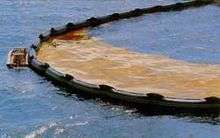Boom (containment)


A containment boom is a temporary floating barrier used to contain an oil spill. Booms are used to reduce the possibility of polluting shorelines and other resources, and to help make recovery easier. Booms help to concentrate oil in thicker surface layers so that skimmers, vacuums, or other collection methods can be used more effectively. They come in many shapes and sizes, with various levels of effectiveness in different types of water conditions."[1]
Often the first containment method to be used and the last equipment to be removed from the site of an oil spill, they are "the most commonly used and most environmentally acceptable response technique to clean up oil spills in the United States."[2]
Booms used in oil spills can be seen as they rest on the surface of the water, but can have between 18 and 48 inches of material that hangs beneath the surface.[3] They're effective in calm water, but as wave height increases oil or other contaminants can easily wash over the top of the boom and render them useless.
In any oil spill, the use of a single conventional boom is not effective in protecting environmental resources even with the correct draft and aspect ratio. For speeds of over 1 knot (of the water and hence the oil), the boom will fail to stop the oil because of drainage under the boom. The approaching oil needs to be decelerated before it meets the boom. Drainage failure may be avoided by using a series of well-designed booms.[4]
Booming tactics
Containment Booming - Placing a boom in a body of contaminated water for the purpose of holding or slowing the movement of contamination.[5]
Diversion Booming - Placing a boom in a body of contaminated water for the purpose of diverting the contamination to a collection point.[6]
Deflection Booming - Placing a boom in a body of water for the sole purpose of changing the course of the contamination.
(Note: This method is used for contamination that is not intended to be recovered, and therefore not typically associated with oil spills)[7]
Exclusion Booming - Placing a boom in a body of water for the purpose of blocking off a sensitive area from contamination.[8]
Exclusion Boom is not recommended for fast water operating environments; consider Diversion Boom or Deflection Boom tactics instead is the advice from [8]. However, when Diversion Boom and Deflection Boom tactics are not suitable and resource protection is still needed, say, fast high tide in a sensitive estuary for instance, then an arrangement of booms with a decelerator is needed.[9][10]
See also
References
- ↑ "Boom (containment), in IncidentNews.gov Glossary". Emergency Response Division, Office of Response and Restoration, National Ocean Service, National Oceanic and Atmospheric Administration, US Department of Commerce. Retrieved 2010-05-18.
- ↑ Joseph Mullin. "Technology Assessment & Research (TA&R) Project Categories: Mechanical Containment and Recovery". Minerals Management Service, US Department of the Interior. Retrieved 2010-05-18. Includes photographs and links to over fifty mechanical containment and recovery projects including containment boom.
- ↑ Derica Williams (2010). "How does oil spill boom protect shores?". WALA-TV. Retrieved 2010-05-19.
- ↑ J. Fang and K.V.Wong, “An Advanced VOF Algorithm for Oil Boom Design", Int. J. Model. and Simulation, Vol. 26, No.1, Jan 2006, pp. 36-44.
- ↑ Mechanical Recovery - Containment and Recovery - Containment Boom (PDF), NUKA Research Planning Group & Spill Tactics for Alaska Responders (STAR), April 2006, retrieved June 8, 2010
- ↑ Mechanical Recovery - Containment and Recov‹›ery - Diversion Boom (PDF), NUKA Research Planning Group & Spill Tactics for Alaska Responders (STAR), April 2006, retrieved June 8, 2010
- ↑ Mechanical Recovery - Containment and Recovery - Deflection Boom (PDF), NUKA Research Planning Group & Spill Tactics for Alaska Responders (STAR), April 2006, retrieved June 8, 2010
- ↑ Mechanical Recovery - Containment and Recovery - Exclusion Boom (PDF), NUKA Research Planning Group & Spill Tactics for Alaska Responders (STAR), April 2006, retrieved June 8, 2010
- ↑ "AN ADVANCED VOF ALGORITHM FOR OIL BOOM DESIGN" (PDF). International Journal of Modelling and Simulation. 26. 2006. Archived from the original (PDF) on June 21, 2010. Retrieved June 16, 2010.
- ↑ US patent 7056059, Kaufui Wong, "Boom with ramped or horizontal skirt structure for slowing the flow speed of buoyant fluids on moving water for fluid, containment, fluid containment system and method", published 2006-06-06
"Boom (containment)." Wikipedia. Wikimedia Foundation, n.d. Web. 07 Sept. 2016.